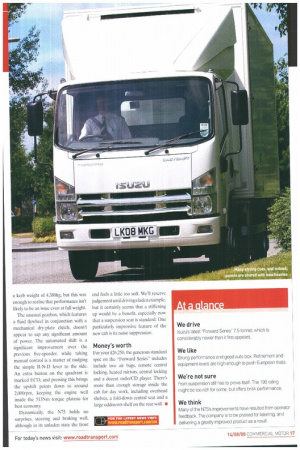More than a name change
Page 16

Page 17

If you've noticed an error in this article please click here to report it so we can fix it.
Some of the new features developed for Isuzu's heavier offerings have trickled down to its more traditional mid-range markets. We jump behind the wheel of one such example, the N75.190.
Words: Colin Barnett / Images: Tom Lee
AMID THE PUBLICITY surrounding Isuzu's new heavier models, it's easy to forget the products in its traditional 3.57.5-tonne markets have gained many of the improvements that the heavies have brought. Pending the new demo fleet getting some running-in mileage for a full road test, we grabbed a new 7.5-tonner -Forward Series" for a drive. The old three-letter naming system has been dropped in favour of a more meaningful code, so what was the old NQR is now an N75.190, which signifies N-Series, 7,500kg GVW and 190PS (188hp).
There's more involved than a new name, however. Although the styling is familiar, apart from the chrome grille, the cab features the same improvements that the larger F-Series brings. These are mainly safety-related, such as door intrusion bars and a significantly reinforced floor structure.
The cab roof aero kit is a Hatcher product. but designed to match the Isuzu's existing styling cues. Access to the driving seat is through a door that opens so wide, you need to remember to pull it shut before you put your seat-belt on.
Powering ahead?
While some rivals only offer 150hp, and others have a 180hp option, the only choice in the Isuzu is an EGR Euro-4 190hp rating. This is a fairly brave move, and one that could frighten off some potential buyers worried about driver and driveline abuse. But this danger is tempered by the standard fitment of a new six-speed automated transmission that softens the power delivery without emasculating it. It still makes a smart getaway when required, though. One unusual dash switch toggles between eight levels of clutch take-up speed, although our drive wasn't long enough to fully experiment. The big red switch next to it, under an aircraft-style flip-up safety cover, activates a limp-home function in the event of a transmission fault.
For this initial drive, we were in an unladen fridge-bodied version with a kerb weight of 4,380kg, but this was enough to realise that performance isn't likely to be an issue even at full weight.
The unusual gearbox, which features a fluid flywheel in conjunction with a mechanical dry-plate clutch, doesn't appear to sap any significant amount of power. The automated shift is a significant improvement over the previous five-speeder, while taking manual control is a matter of nudging the simple R-N-D lever to the side. An extra button on the quadrant is marked ECO, and pressing this brings the upshift points down to around 2,000rpm, keeping the engine well inside the 513Nm torque plateau for best economy.
Dynamically, the N75 holds no surprises, steering and braking well, although in its unladen state the front end feels a little too soft. We'll reserve judgement until driving a laden example, but it certainly seems that a stiffening up would be a benefit, especially now that a suspension seat is standard. One particularly impressive feature of the new cab is its noise suppression.
Money's worth
For your £26,250, the generous standard spec on the "Forward Series" includes include two air bags, remote central locking, heated mirrors, central locking and a decent radio/CD player. There's more than enough storage inside the cab for day work, including overhead shelves, a fold-down central seat and a large oddments shelf on the rear wall. •
































































































































































